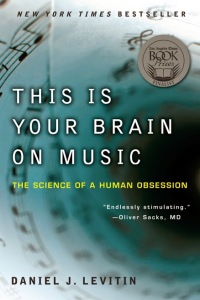Today I wanna share a book that I have recently told a friend about. It’s not new (actually, to be true, I’ve read it a while ago, so I don’t recall to many details about it), so some of you may already know it. Called “This Is Your Brain on Music: The Science of a Human Obsession” (by Daniel J. Levitin), it’s a great book about music, sound and neuroscience.
Daniel talks a lot about what makes a song a hit (according to neuroscience); how our brain understand musical patterns, timbers and rhythms; and why that little f*** jingle sticks
in our heads even thought we hate it.
The thing about this book is that, more than being fun to read and having some interesting facts (that you can tell your friends in a bar table, and fell intelligent), it really helped me understand how to compose better and simples songs and how to mix better, based on our perceptions and brain structure. Also, the things he says about “making a hit” are really interesting, in the business point of view.
Here are some reviews of the book:
From Scientific American
Everyone knows that music can calm a savage beast, rouse a marching platoon or move lovers to tears. But no one knows exactly how. Daniel Levitin, a professional musician, record producer and now neuroscientist at McGill University, explains the latest thinking into why tunes touch us so deeply. He also speculates about whether specific pathways have evolved in our brain for making and listening to music. Using brain imaging, Levitin has documented neural activation in people as they listen to music, revealing a novel cascade of excitation that begins in the auditory system and spreads to regions related to planning, expectation and language as well as arousal, pleasure, mood and rhythmic movement. “Music listening, performance and composition engage nearly every area of the brain that we have so far identifi ed and involve nearly every neural subsystem,” he notes. Music’s effects on neurons are so distributed that in some cases stroke victims who can no longer decipher letters can still read music, and some impaired individuals who cannot button a sweater can nevertheless play the piano. Levitin describes new insights into these conditions as well as disorders that cause certain individuals to lack empathy, emotional perception and musicality. He and others suspect a cluster of genes may influence both outgoingness and music ability. He also posits that music promotes cognitive development. Not surprisingly, music reaches deep into the brain’s most primitive structures—including our ancient “reptilian brain” tied to motivation, reward and emotion. Music elevates dopamine levels in the brain’s mood and pleasure centers in ways similar to those triggered by narcotics and antidepressants. Levitin also explains how the neural underpinnings of auditory stimulation and mate selection reach far back in life’s evolutionary scheme. Levitin has no agenda per se, although the book is a rebuttal of sorts to scientists who say music has served no purpose other than to pleasurably stimulate auditory nerve endings. He simply explains an emerging view about the coevolution of music and the brain. To tell his tale, Levitin engagingly weaves together strands of his own life as a professional musician (who dropped out of college to form a band) with those of his transformation into a neuroscientist. To revel in Ra vel’s Boléro or Charlie Parker’s Koko, he reminds us, is to stimulate the brain in a “choreography of neurochemical release and uptake between logical prediction systems and emotional reward systems”—a ballet of brain regions “ex quisitely orchestrated.”
From Publishers Weekly
Starred Review. Think of a song that resonates deep down in your being. Now imagine sitting down with someone who was there when the song was recorded and can tell you how that series of sounds was committed to tape, and who can also explain why that particular combination of rhythms, timbres and pitches has lodged in your memory, making your pulse race and your heart swell every time you hear it. Remarkably, Levitin does all this and more, interrogating the basic nature of hearing and of music making (this is likely the only book whose jacket sports blurbs from both Oliver Sacks and Stevie Wonder), without losing an affectionate appreciation for the songs he’s reducing to neural impulses. Levitin is the ideal guide to this material: he enjoyed a successful career as a rock musician and studio producer before turning to cognitive neuroscience, earning a Ph.D. and becoming a top researcher into how our brains interpret music. Though the book starts off a little dryly (the first chapter is a crash course in music theory), Levitin’s snappy prose and relaxed style quickly win one over and will leave readers thinking about the contents of their iPods in an entirely new way. (Aug.)
Copyright © Reed Business Information, a division of Reed Elsevier Inc. All rights reserved.
So, if you want a weekend reading, this can be a nice book!
Hope you enjoy it! 🙂
Mauricio Ruiz – www.mauricioruiz.me